Statistics II: Repeated Measures ANOVA Design and Data Analysis
VerifiedAdded on 2023/06/15
|21
|2295
|329
Report
AI Summary
This report provides a comprehensive analysis of repeated measures ANOVA, utilizing a provided dataset to determine if student test scores increase over a 12-week period. The analysis includes exploratory data analysis, repeated measures ANOVA calculations, and interpretation of SPSS outputs. The report examines the effects of gender and time on test scores, including tests for sphericity and post-hoc analyses. Additionally, the report discusses the analytical strategy of ANOVA, suggesting the inclusion of variables such as average study hours and IQ level for enhanced analysis, while emphasizing the importance of maintaining sphericity. The findings suggest that while overall test scores increase over time, the effect of gender is negligible.

Running head: STATISTICS 2
Statistics 2
Name of the student:
Name of the university:
Author’s note:
Statistics 2
Name of the student:
Name of the university:
Author’s note:
Paraphrase This Document
Need a fresh take? Get an instant paraphrase of this document with our AI Paraphraser
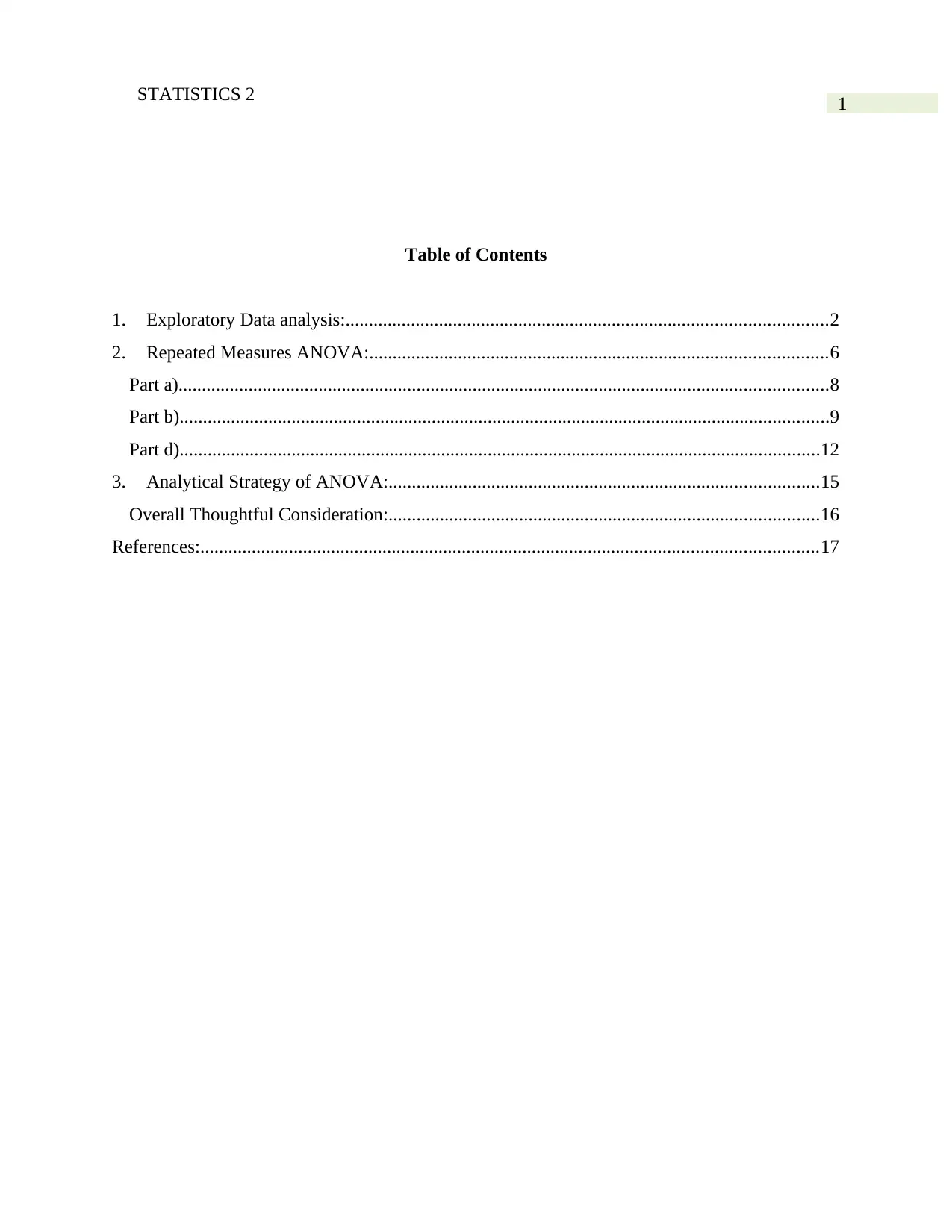
1STATISTICS 2
Table of Contents
1. Exploratory Data analysis:.......................................................................................................2
2. Repeated Measures ANOVA:..................................................................................................6
Part a)...........................................................................................................................................8
Part b)...........................................................................................................................................9
Part d).........................................................................................................................................12
3. Analytical Strategy of ANOVA:............................................................................................15
Overall Thoughtful Consideration:............................................................................................16
References:....................................................................................................................................17
Table of Contents
1. Exploratory Data analysis:.......................................................................................................2
2. Repeated Measures ANOVA:..................................................................................................6
Part a)...........................................................................................................................................8
Part b)...........................................................................................................................................9
Part d).........................................................................................................................................12
3. Analytical Strategy of ANOVA:............................................................................................15
Overall Thoughtful Consideration:............................................................................................16
References:....................................................................................................................................17
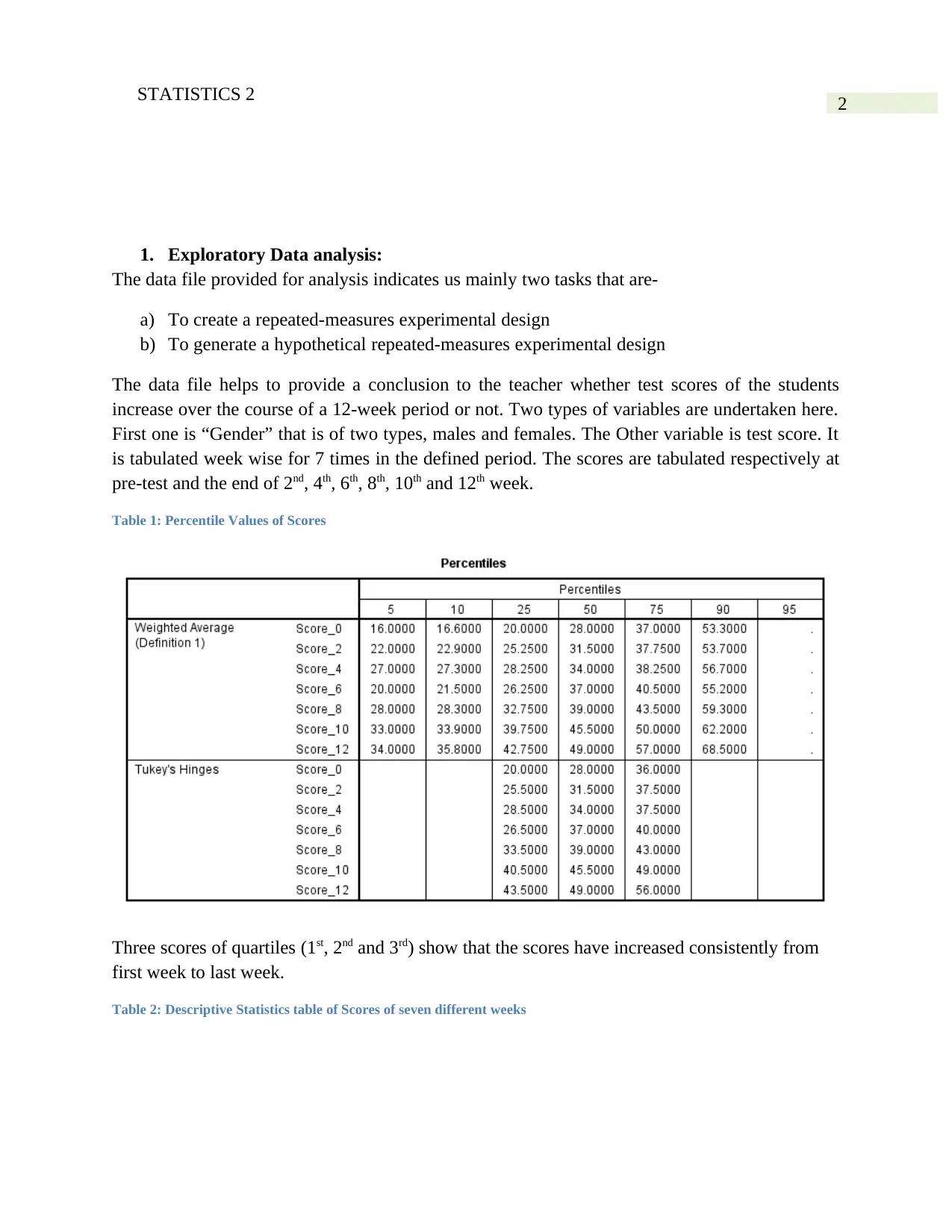
2STATISTICS 2
1. Exploratory Data analysis:
The data file provided for analysis indicates us mainly two tasks that are-
a) To create a repeated-measures experimental design
b) To generate a hypothetical repeated-measures experimental design
The data file helps to provide a conclusion to the teacher whether test scores of the students
increase over the course of a 12-week period or not. Two types of variables are undertaken here.
First one is “Gender” that is of two types, males and females. The Other variable is test score. It
is tabulated week wise for 7 times in the defined period. The scores are tabulated respectively at
pre-test and the end of 2nd, 4th, 6th, 8th, 10th and 12th week.
Table 1: Percentile Values of Scores
Three scores of quartiles (1st, 2nd and 3rd) show that the scores have increased consistently from
first week to last week.
Table 2: Descriptive Statistics table of Scores of seven different weeks
1. Exploratory Data analysis:
The data file provided for analysis indicates us mainly two tasks that are-
a) To create a repeated-measures experimental design
b) To generate a hypothetical repeated-measures experimental design
The data file helps to provide a conclusion to the teacher whether test scores of the students
increase over the course of a 12-week period or not. Two types of variables are undertaken here.
First one is “Gender” that is of two types, males and females. The Other variable is test score. It
is tabulated week wise for 7 times in the defined period. The scores are tabulated respectively at
pre-test and the end of 2nd, 4th, 6th, 8th, 10th and 12th week.
Table 1: Percentile Values of Scores
Three scores of quartiles (1st, 2nd and 3rd) show that the scores have increased consistently from
first week to last week.
Table 2: Descriptive Statistics table of Scores of seven different weeks
⊘ This is a preview!⊘
Do you want full access?
Subscribe today to unlock all pages.

Trusted by 1+ million students worldwide
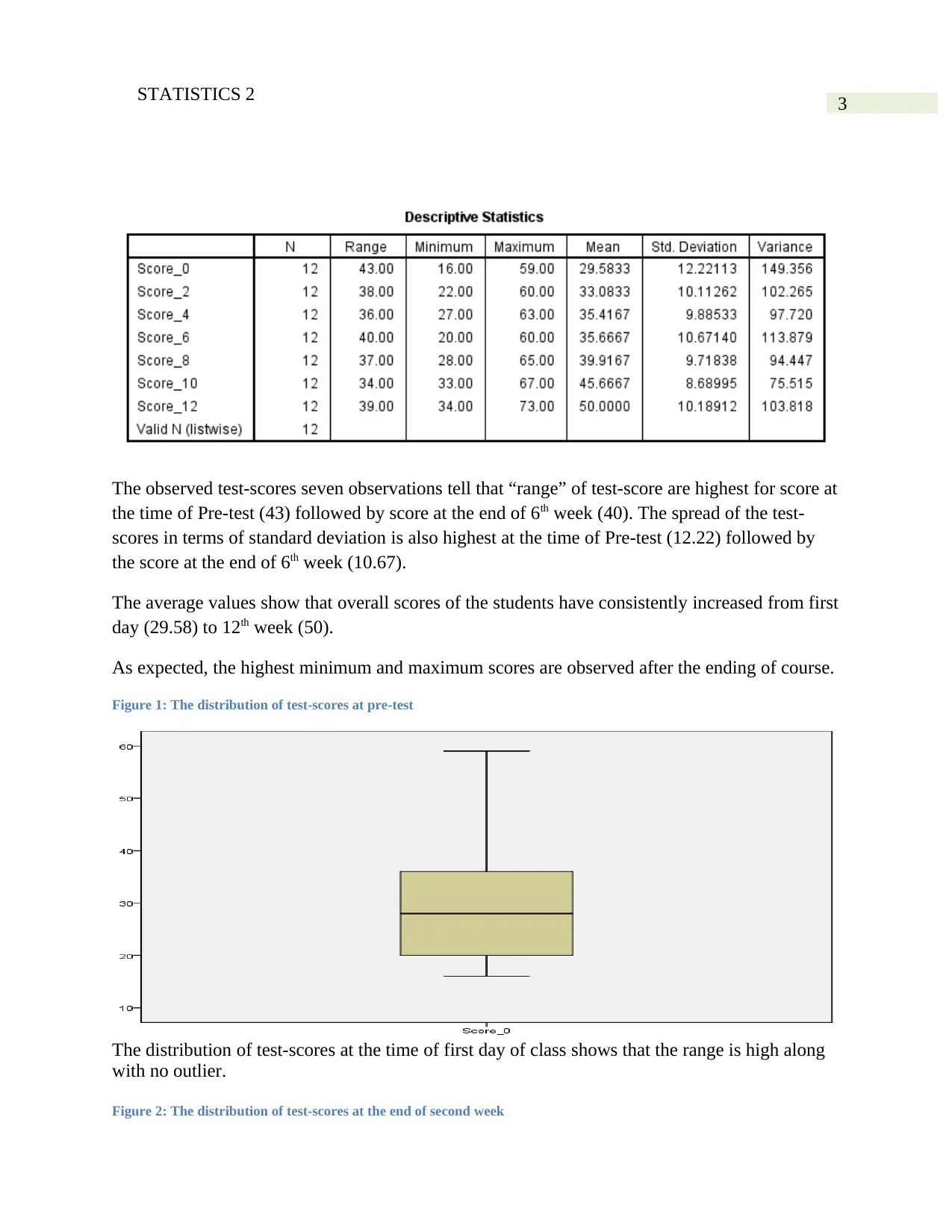
3STATISTICS 2
The observed test-scores seven observations tell that “range” of test-score are highest for score at
the time of Pre-test (43) followed by score at the end of 6th week (40). The spread of the test-
scores in terms of standard deviation is also highest at the time of Pre-test (12.22) followed by
the score at the end of 6th week (10.67).
The average values show that overall scores of the students have consistently increased from first
day (29.58) to 12th week (50).
As expected, the highest minimum and maximum scores are observed after the ending of course.
Figure 1: The distribution of test-scores at pre-test
The distribution of test-scores at the time of first day of class shows that the range is high along
with no outlier.
Figure 2: The distribution of test-scores at the end of second week
The observed test-scores seven observations tell that “range” of test-score are highest for score at
the time of Pre-test (43) followed by score at the end of 6th week (40). The spread of the test-
scores in terms of standard deviation is also highest at the time of Pre-test (12.22) followed by
the score at the end of 6th week (10.67).
The average values show that overall scores of the students have consistently increased from first
day (29.58) to 12th week (50).
As expected, the highest minimum and maximum scores are observed after the ending of course.
Figure 1: The distribution of test-scores at pre-test
The distribution of test-scores at the time of first day of class shows that the range is high along
with no outlier.
Figure 2: The distribution of test-scores at the end of second week
Paraphrase This Document
Need a fresh take? Get an instant paraphrase of this document with our AI Paraphraser
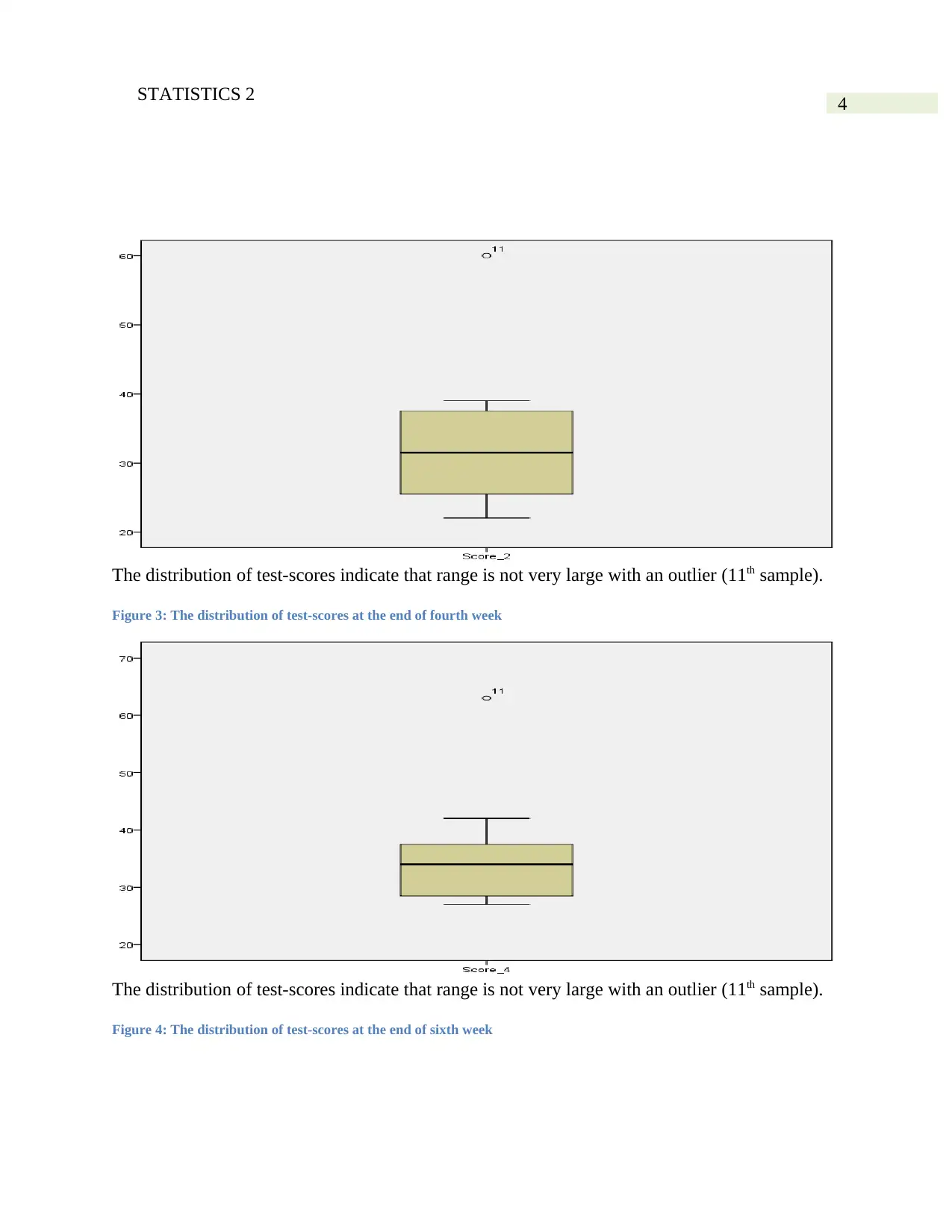
4STATISTICS 2
The distribution of test-scores indicate that range is not very large with an outlier (11th sample).
Figure 3: The distribution of test-scores at the end of fourth week
The distribution of test-scores indicate that range is not very large with an outlier (11th sample).
Figure 4: The distribution of test-scores at the end of sixth week
The distribution of test-scores indicate that range is not very large with an outlier (11th sample).
Figure 3: The distribution of test-scores at the end of fourth week
The distribution of test-scores indicate that range is not very large with an outlier (11th sample).
Figure 4: The distribution of test-scores at the end of sixth week
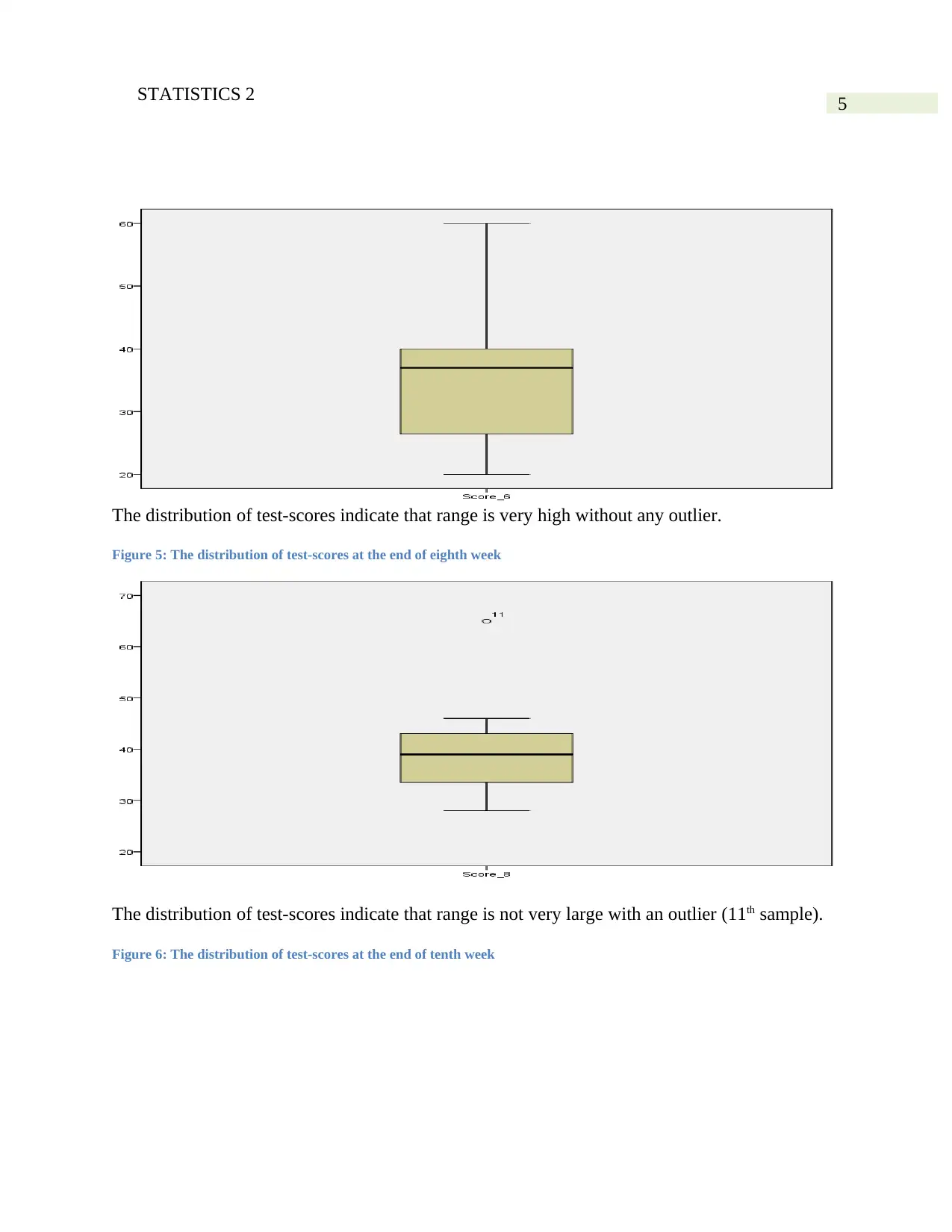
5STATISTICS 2
The distribution of test-scores indicate that range is very high without any outlier.
Figure 5: The distribution of test-scores at the end of eighth week
The distribution of test-scores indicate that range is not very large with an outlier (11th sample).
Figure 6: The distribution of test-scores at the end of tenth week
The distribution of test-scores indicate that range is very high without any outlier.
Figure 5: The distribution of test-scores at the end of eighth week
The distribution of test-scores indicate that range is not very large with an outlier (11th sample).
Figure 6: The distribution of test-scores at the end of tenth week
⊘ This is a preview!⊘
Do you want full access?
Subscribe today to unlock all pages.

Trusted by 1+ million students worldwide
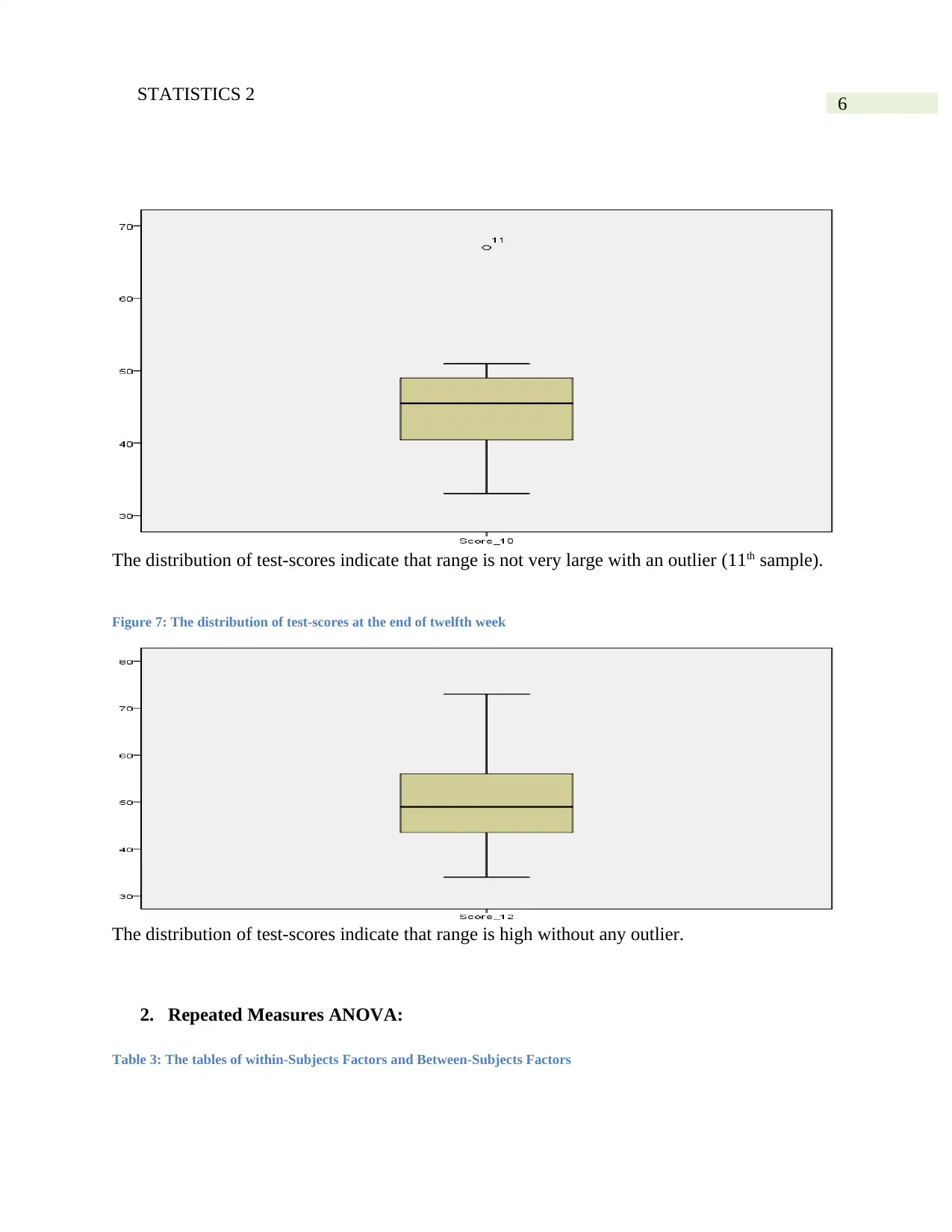
6STATISTICS 2
The distribution of test-scores indicate that range is not very large with an outlier (11th sample).
Figure 7: The distribution of test-scores at the end of twelfth week
The distribution of test-scores indicate that range is high without any outlier.
2. Repeated Measures ANOVA:
Table 3: The tables of within-Subjects Factors and Between-Subjects Factors
The distribution of test-scores indicate that range is not very large with an outlier (11th sample).
Figure 7: The distribution of test-scores at the end of twelfth week
The distribution of test-scores indicate that range is high without any outlier.
2. Repeated Measures ANOVA:
Table 3: The tables of within-Subjects Factors and Between-Subjects Factors
Paraphrase This Document
Need a fresh take? Get an instant paraphrase of this document with our AI Paraphraser
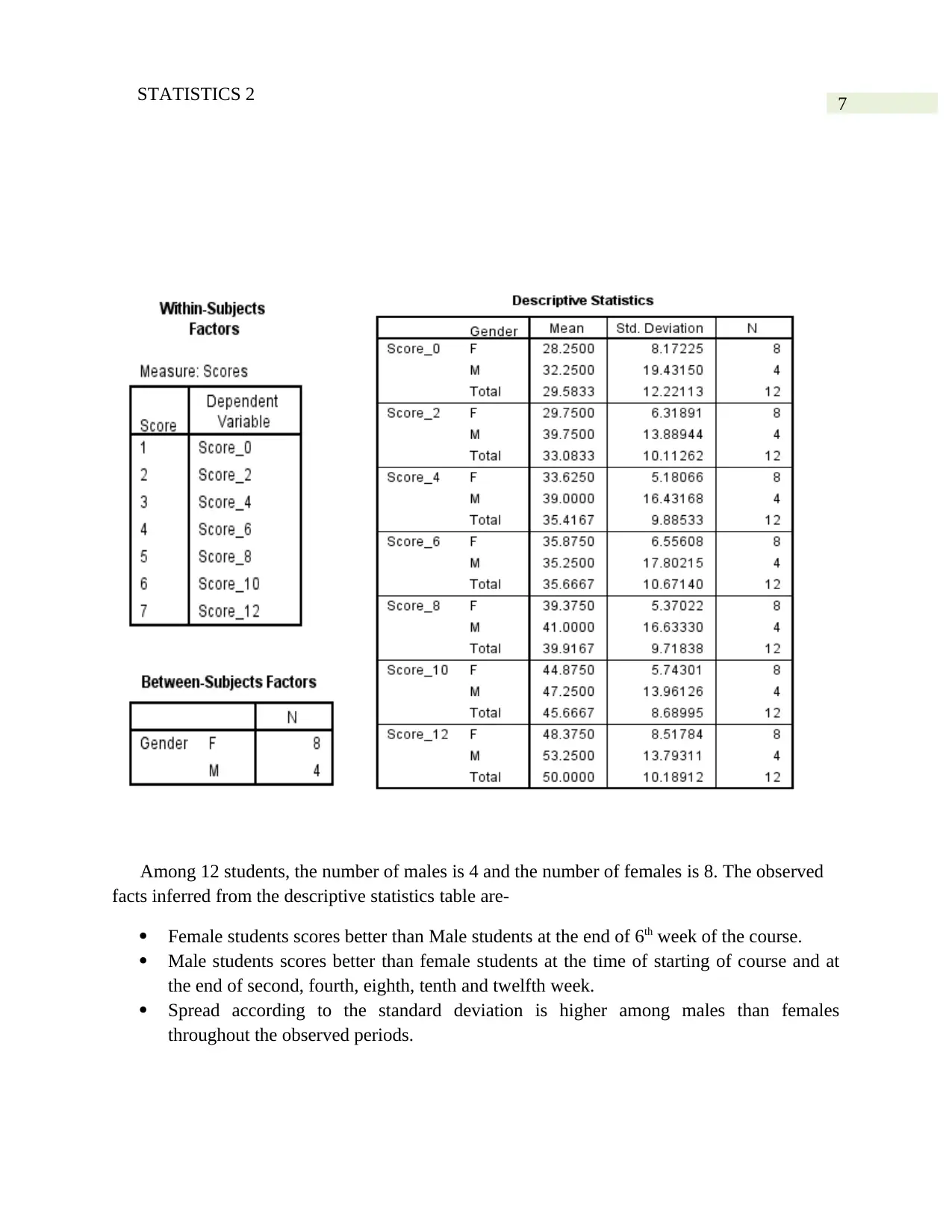
7STATISTICS 2
Among 12 students, the number of males is 4 and the number of females is 8. The observed
facts inferred from the descriptive statistics table are-
Female students scores better than Male students at the end of 6th week of the course.
Male students scores better than female students at the time of starting of course and at
the end of second, fourth, eighth, tenth and twelfth week.
Spread according to the standard deviation is higher among males than females
throughout the observed periods.
Among 12 students, the number of males is 4 and the number of females is 8. The observed
facts inferred from the descriptive statistics table are-
Female students scores better than Male students at the end of 6th week of the course.
Male students scores better than female students at the time of starting of course and at
the end of second, fourth, eighth, tenth and twelfth week.
Spread according to the standard deviation is higher among males than females
throughout the observed periods.
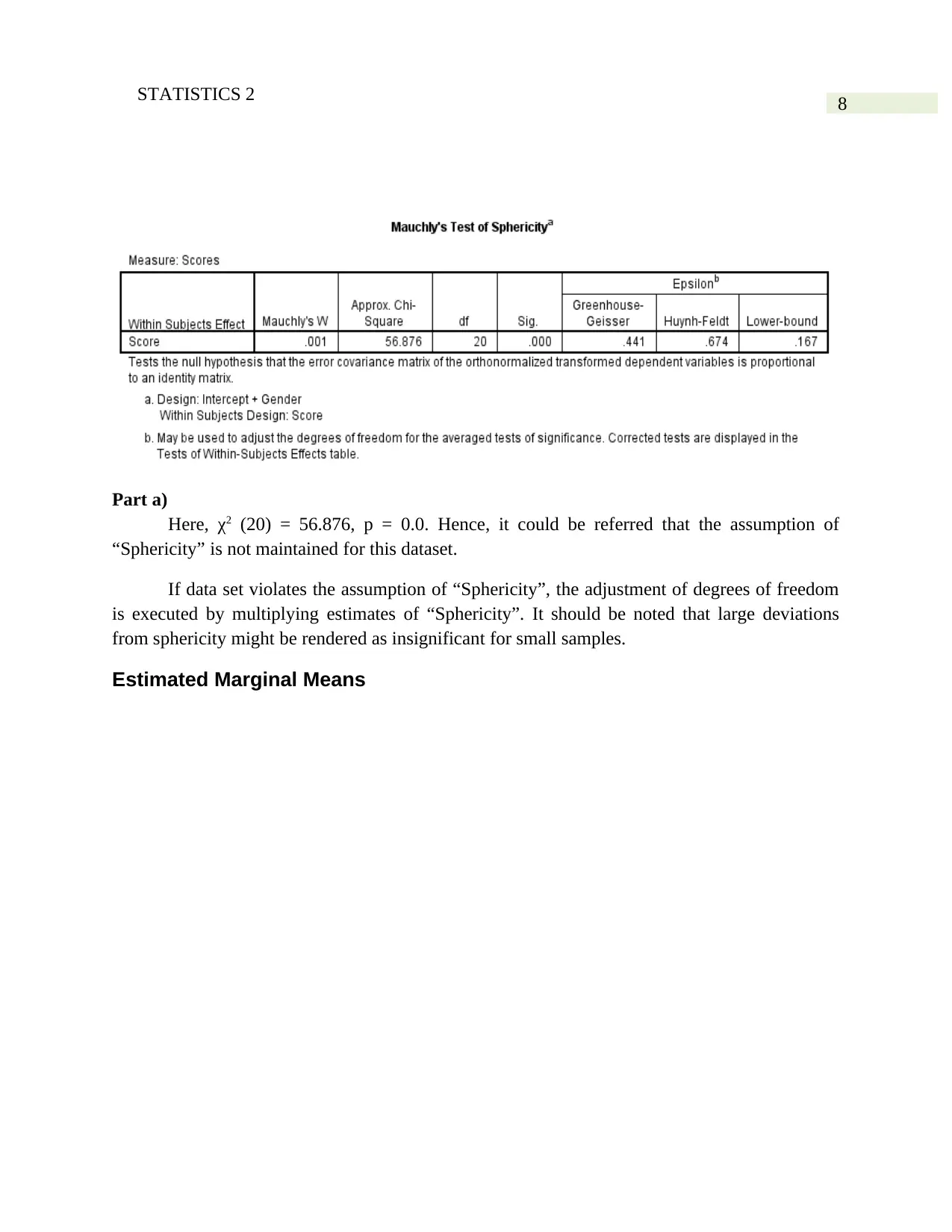
8STATISTICS 2
Part a)
Here, χ2 (20) = 56.876, p = 0.0. Hence, it could be referred that the assumption of
“Sphericity” is not maintained for this dataset.
If data set violates the assumption of “Sphericity”, the adjustment of degrees of freedom
is executed by multiplying estimates of “Sphericity”. It should be noted that large deviations
from sphericity might be rendered as insignificant for small samples.
Estimated Marginal Means
Part a)
Here, χ2 (20) = 56.876, p = 0.0. Hence, it could be referred that the assumption of
“Sphericity” is not maintained for this dataset.
If data set violates the assumption of “Sphericity”, the adjustment of degrees of freedom
is executed by multiplying estimates of “Sphericity”. It should be noted that large deviations
from sphericity might be rendered as insignificant for small samples.
Estimated Marginal Means
⊘ This is a preview!⊘
Do you want full access?
Subscribe today to unlock all pages.

Trusted by 1+ million students worldwide
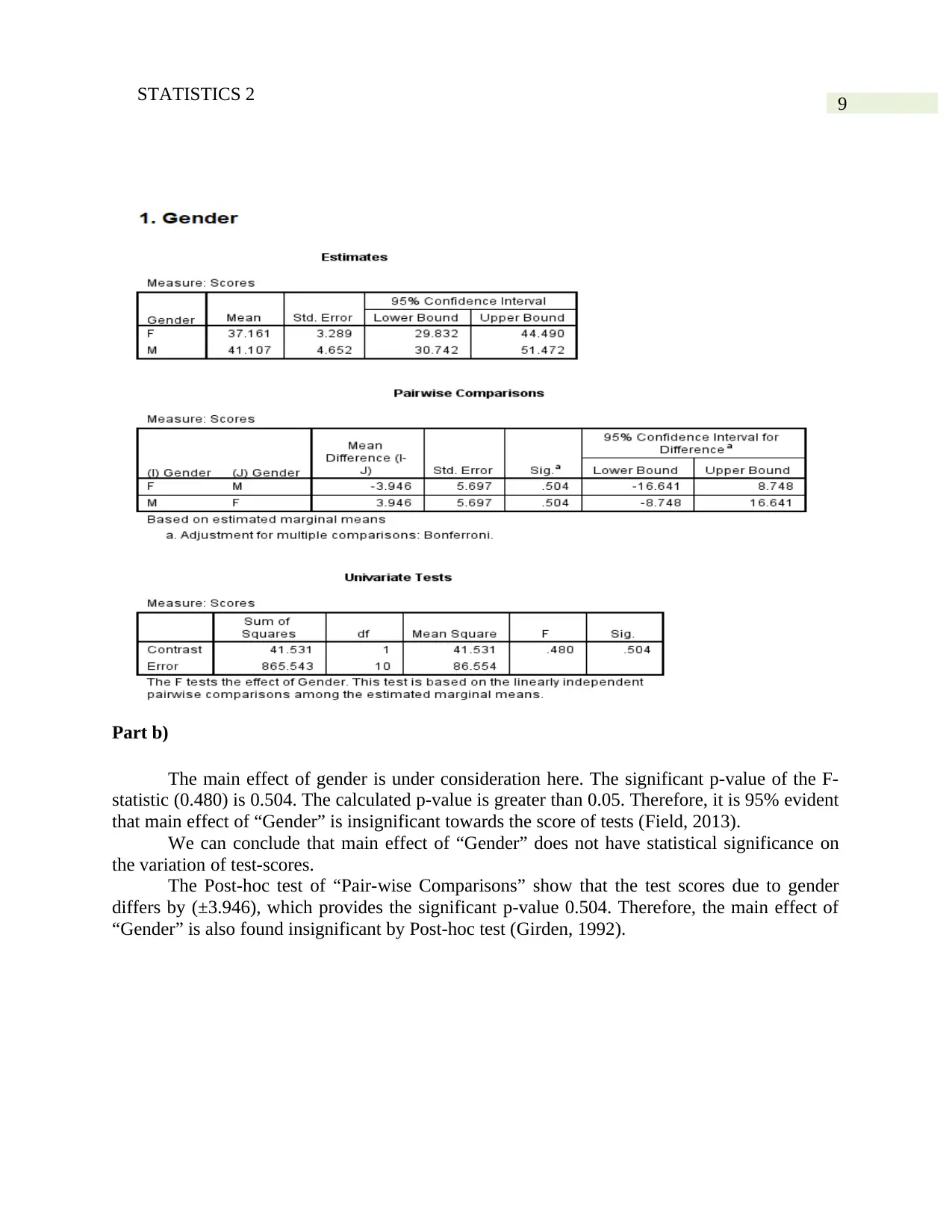
9STATISTICS 2
Part b)
The main effect of gender is under consideration here. The significant p-value of the F-
statistic (0.480) is 0.504. The calculated p-value is greater than 0.05. Therefore, it is 95% evident
that main effect of “Gender” is insignificant towards the score of tests (Field, 2013).
We can conclude that main effect of “Gender” does not have statistical significance on
the variation of test-scores.
The Post-hoc test of “Pair-wise Comparisons” show that the test scores due to gender
differs by (±3.946), which provides the significant p-value 0.504. Therefore, the main effect of
“Gender” is also found insignificant by Post-hoc test (Girden, 1992).
Part b)
The main effect of gender is under consideration here. The significant p-value of the F-
statistic (0.480) is 0.504. The calculated p-value is greater than 0.05. Therefore, it is 95% evident
that main effect of “Gender” is insignificant towards the score of tests (Field, 2013).
We can conclude that main effect of “Gender” does not have statistical significance on
the variation of test-scores.
The Post-hoc test of “Pair-wise Comparisons” show that the test scores due to gender
differs by (±3.946), which provides the significant p-value 0.504. Therefore, the main effect of
“Gender” is also found insignificant by Post-hoc test (Girden, 1992).
Paraphrase This Document
Need a fresh take? Get an instant paraphrase of this document with our AI Paraphraser
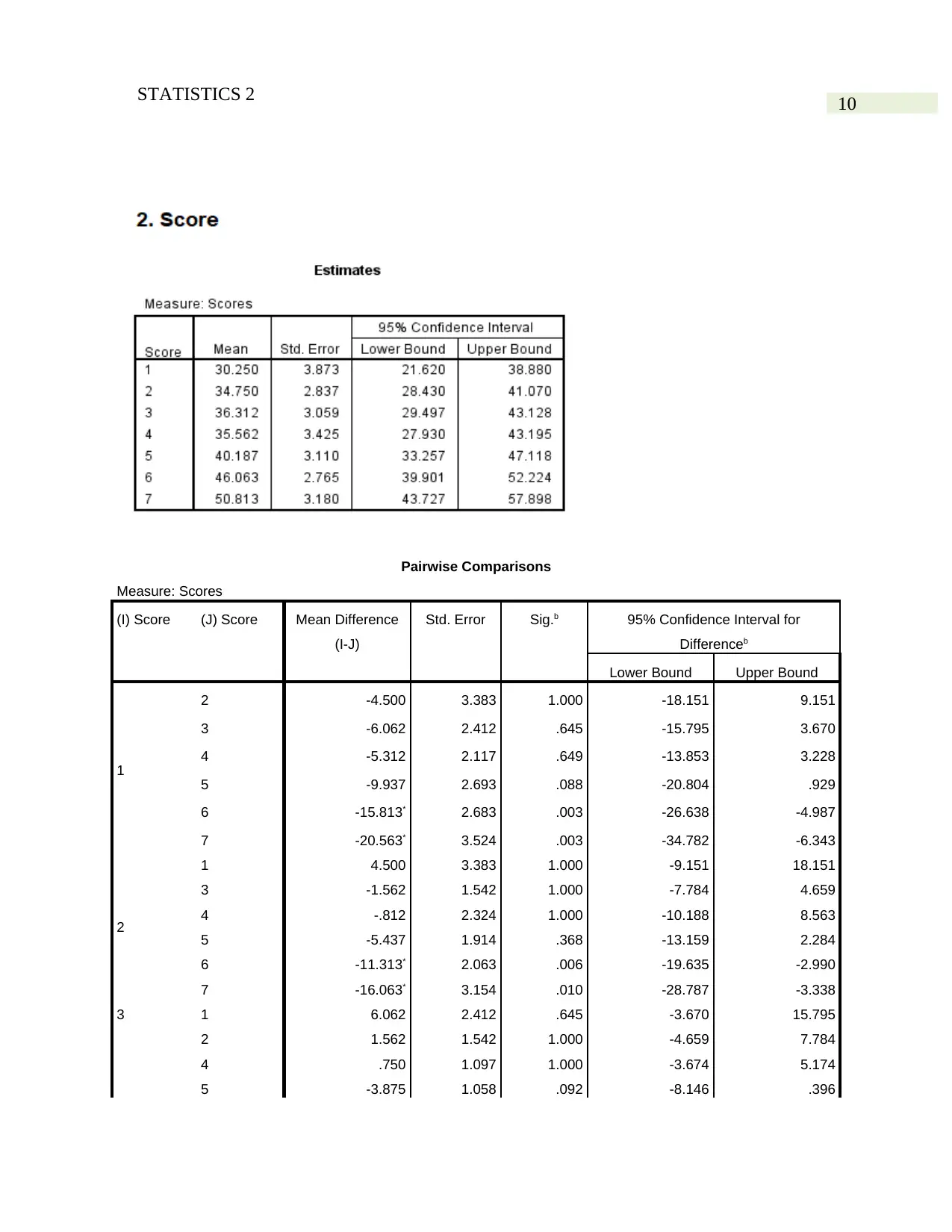
10STATISTICS 2
Pairwise Comparisons
Measure: Scores
(I) Score (J) Score Mean Difference
(I-J)
Std. Error Sig.b 95% Confidence Interval for
Differenceb
Lower Bound Upper Bound
1
2 -4.500 3.383 1.000 -18.151 9.151
3 -6.062 2.412 .645 -15.795 3.670
4 -5.312 2.117 .649 -13.853 3.228
5 -9.937 2.693 .088 -20.804 .929
6 -15.813* 2.683 .003 -26.638 -4.987
7 -20.563* 3.524 .003 -34.782 -6.343
2
1 4.500 3.383 1.000 -9.151 18.151
3 -1.562 1.542 1.000 -7.784 4.659
4 -.812 2.324 1.000 -10.188 8.563
5 -5.437 1.914 .368 -13.159 2.284
6 -11.313* 2.063 .006 -19.635 -2.990
7 -16.063* 3.154 .010 -28.787 -3.338
3 1 6.062 2.412 .645 -3.670 15.795
2 1.562 1.542 1.000 -4.659 7.784
4 .750 1.097 1.000 -3.674 5.174
5 -3.875 1.058 .092 -8.146 .396
Pairwise Comparisons
Measure: Scores
(I) Score (J) Score Mean Difference
(I-J)
Std. Error Sig.b 95% Confidence Interval for
Differenceb
Lower Bound Upper Bound
1
2 -4.500 3.383 1.000 -18.151 9.151
3 -6.062 2.412 .645 -15.795 3.670
4 -5.312 2.117 .649 -13.853 3.228
5 -9.937 2.693 .088 -20.804 .929
6 -15.813* 2.683 .003 -26.638 -4.987
7 -20.563* 3.524 .003 -34.782 -6.343
2
1 4.500 3.383 1.000 -9.151 18.151
3 -1.562 1.542 1.000 -7.784 4.659
4 -.812 2.324 1.000 -10.188 8.563
5 -5.437 1.914 .368 -13.159 2.284
6 -11.313* 2.063 .006 -19.635 -2.990
7 -16.063* 3.154 .010 -28.787 -3.338
3 1 6.062 2.412 .645 -3.670 15.795
2 1.562 1.542 1.000 -4.659 7.784
4 .750 1.097 1.000 -3.674 5.174
5 -3.875 1.058 .092 -8.146 .396
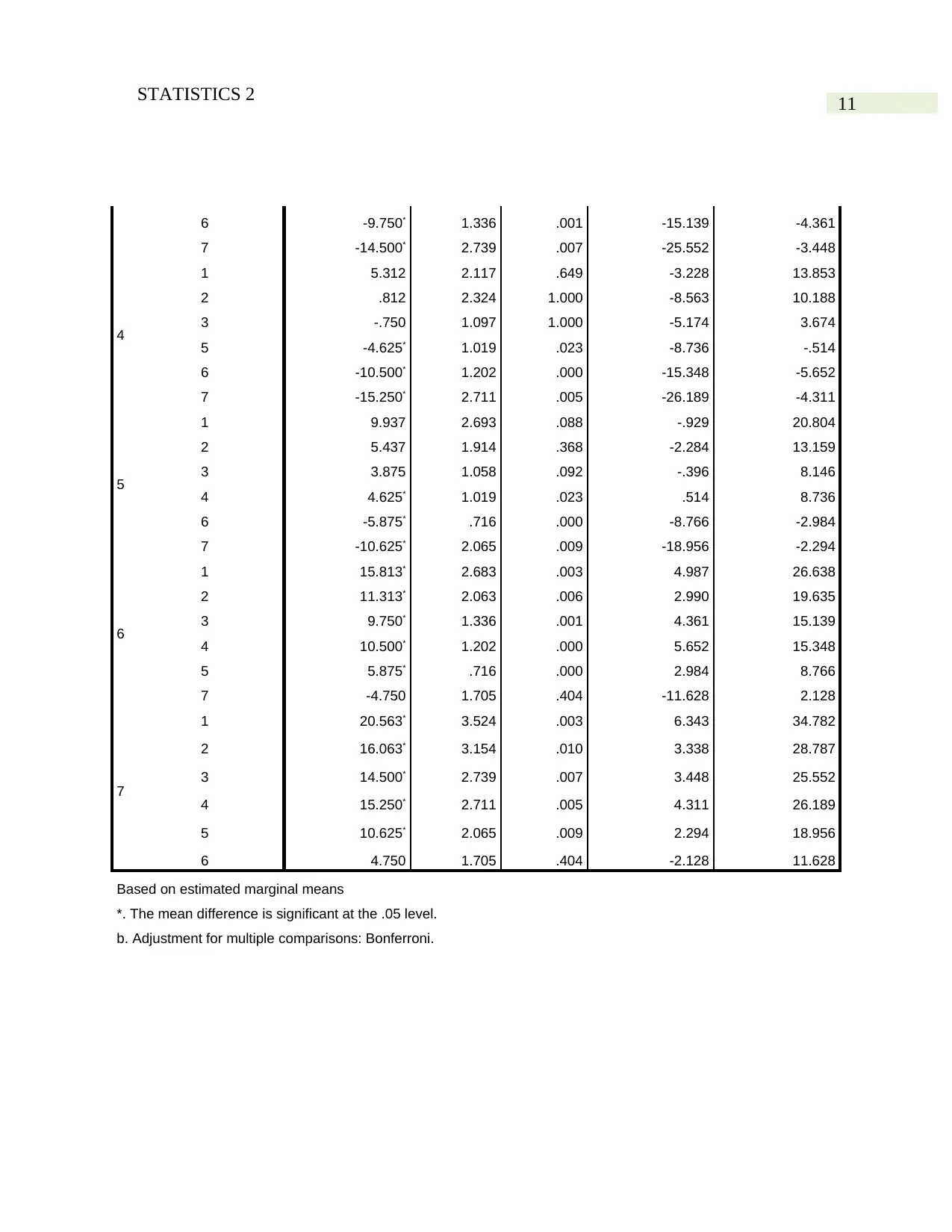
11STATISTICS 2
6 -9.750* 1.336 .001 -15.139 -4.361
7 -14.500* 2.739 .007 -25.552 -3.448
4
1 5.312 2.117 .649 -3.228 13.853
2 .812 2.324 1.000 -8.563 10.188
3 -.750 1.097 1.000 -5.174 3.674
5 -4.625* 1.019 .023 -8.736 -.514
6 -10.500* 1.202 .000 -15.348 -5.652
7 -15.250* 2.711 .005 -26.189 -4.311
5
1 9.937 2.693 .088 -.929 20.804
2 5.437 1.914 .368 -2.284 13.159
3 3.875 1.058 .092 -.396 8.146
4 4.625* 1.019 .023 .514 8.736
6 -5.875* .716 .000 -8.766 -2.984
7 -10.625* 2.065 .009 -18.956 -2.294
6
1 15.813* 2.683 .003 4.987 26.638
2 11.313* 2.063 .006 2.990 19.635
3 9.750* 1.336 .001 4.361 15.139
4 10.500* 1.202 .000 5.652 15.348
5 5.875* .716 .000 2.984 8.766
7 -4.750 1.705 .404 -11.628 2.128
7
1 20.563* 3.524 .003 6.343 34.782
2 16.063* 3.154 .010 3.338 28.787
3 14.500* 2.739 .007 3.448 25.552
4 15.250* 2.711 .005 4.311 26.189
5 10.625* 2.065 .009 2.294 18.956
6 4.750 1.705 .404 -2.128 11.628
Based on estimated marginal means
*. The mean difference is significant at the .05 level.
b. Adjustment for multiple comparisons: Bonferroni.
6 -9.750* 1.336 .001 -15.139 -4.361
7 -14.500* 2.739 .007 -25.552 -3.448
4
1 5.312 2.117 .649 -3.228 13.853
2 .812 2.324 1.000 -8.563 10.188
3 -.750 1.097 1.000 -5.174 3.674
5 -4.625* 1.019 .023 -8.736 -.514
6 -10.500* 1.202 .000 -15.348 -5.652
7 -15.250* 2.711 .005 -26.189 -4.311
5
1 9.937 2.693 .088 -.929 20.804
2 5.437 1.914 .368 -2.284 13.159
3 3.875 1.058 .092 -.396 8.146
4 4.625* 1.019 .023 .514 8.736
6 -5.875* .716 .000 -8.766 -2.984
7 -10.625* 2.065 .009 -18.956 -2.294
6
1 15.813* 2.683 .003 4.987 26.638
2 11.313* 2.063 .006 2.990 19.635
3 9.750* 1.336 .001 4.361 15.139
4 10.500* 1.202 .000 5.652 15.348
5 5.875* .716 .000 2.984 8.766
7 -4.750 1.705 .404 -11.628 2.128
7
1 20.563* 3.524 .003 6.343 34.782
2 16.063* 3.154 .010 3.338 28.787
3 14.500* 2.739 .007 3.448 25.552
4 15.250* 2.711 .005 4.311 26.189
5 10.625* 2.065 .009 2.294 18.956
6 4.750 1.705 .404 -2.128 11.628
Based on estimated marginal means
*. The mean difference is significant at the .05 level.
b. Adjustment for multiple comparisons: Bonferroni.
⊘ This is a preview!⊘
Do you want full access?
Subscribe today to unlock all pages.

Trusted by 1+ million students worldwide
1 out of 21
Your All-in-One AI-Powered Toolkit for Academic Success.
+13062052269
info@desklib.com
Available 24*7 on WhatsApp / Email
![[object Object]](/_next/static/media/star-bottom.7253800d.svg)
Unlock your academic potential
Copyright © 2020–2025 A2Z Services. All Rights Reserved. Developed and managed by ZUCOL.


